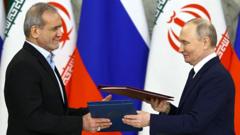As the crisis unfolds, Trump’s ambiguous statements leave the world on edge regarding U.S. military intervention while Iran's leaders vehemently reject negotiations under threat, setting the stage for further escalation in the Middle East.
**Tensions Escalate: Trump Weighs Action on Iran Amid Ongoing Israeli Strikes**

**Tensions Escalate: Trump Weighs Action on Iran Amid Ongoing Israeli Strikes**
President Donald Trump remains undecided on potential military strikes against Iran amid escalating conflict, focusing on the implications of direct U.S. involvement in the ongoing Israeli attacks targeting Iranian nuclear capabilities.
***
In a critical juncture of international relations, President Donald Trump acknowledged on June 18 that he has not finalised a decision on whether the United States will engage in military action alongside Israel against Iranian nuclear sites. His statements came after a tumultuous week, marking the sixth day of an Israeli offensive aimed at crippling Iran’s nuclear program.
During a press event, Trump cryptically noted, “I like to make a final decision one second before,” igniting speculation regarding his capacity to judge the unfolding geopolitical situation. As tensions rise, Americans and international observers lingered on his comments, interpreting them as a harbinger of possible military action. Furthermore, Trump insinuated that Iran could have negotiated terms before the violent flare-up of conflict, emphasizing, “Why didn’t you negotiate with me before all this destruction?”
Simultaneously, Iran’s supreme leader, Ayatollah Ali Khamenei, issued a forceful rebuke to Trump’s rhetoric, dismissing his call for “unconditional surrender” as a futile threat that would be met with fierce resistance. Khamenei underscored that any U.S. military interference would result in “irreparable damage.” This tension culminates amidst ongoing strikes by Israel aimed at undermining Iran’s military capacities and nuclear ambitions.
In an urgent notice, U.S. Ambassador Mike Huckabee urged citizens in Israel to consider evacuation options, hinting at the severity of the current conflict. Alongside the operational challenges posed by Iran’s missile capabilities, the current wave of violence is problematic for both the U.S. and Israeli leadership, particularly with U.S. forces stationed in various locations across the Middle East.
Amid these political intricacies, Iran's communications have become increasingly tenuous, disrupted by national internet outages, limiting the flow of information about the consequences of the ongoing airstrikes.
While domestic sentiment within Israel may currently lean towards optimism as Prime Minister Benjamin Netanyahu garners public support, the wider implications of further escalation remain concerning. Potential consequences for U.S. military personnel stationed in the region cast a long shadow over the decision-making process.
The coming days may prove pivotal, as both Iranian and U.S. leaders navigate a complex landscape defined by military, political, and public pressure. In this intricate geopolitical arena, the threat of exacerbation remains prevalent, leaving the Middle East at a critical threshold.
In a critical juncture of international relations, President Donald Trump acknowledged on June 18 that he has not finalised a decision on whether the United States will engage in military action alongside Israel against Iranian nuclear sites. His statements came after a tumultuous week, marking the sixth day of an Israeli offensive aimed at crippling Iran’s nuclear program.
During a press event, Trump cryptically noted, “I like to make a final decision one second before,” igniting speculation regarding his capacity to judge the unfolding geopolitical situation. As tensions rise, Americans and international observers lingered on his comments, interpreting them as a harbinger of possible military action. Furthermore, Trump insinuated that Iran could have negotiated terms before the violent flare-up of conflict, emphasizing, “Why didn’t you negotiate with me before all this destruction?”
Simultaneously, Iran’s supreme leader, Ayatollah Ali Khamenei, issued a forceful rebuke to Trump’s rhetoric, dismissing his call for “unconditional surrender” as a futile threat that would be met with fierce resistance. Khamenei underscored that any U.S. military interference would result in “irreparable damage.” This tension culminates amidst ongoing strikes by Israel aimed at undermining Iran’s military capacities and nuclear ambitions.
In an urgent notice, U.S. Ambassador Mike Huckabee urged citizens in Israel to consider evacuation options, hinting at the severity of the current conflict. Alongside the operational challenges posed by Iran’s missile capabilities, the current wave of violence is problematic for both the U.S. and Israeli leadership, particularly with U.S. forces stationed in various locations across the Middle East.
Amid these political intricacies, Iran's communications have become increasingly tenuous, disrupted by national internet outages, limiting the flow of information about the consequences of the ongoing airstrikes.
While domestic sentiment within Israel may currently lean towards optimism as Prime Minister Benjamin Netanyahu garners public support, the wider implications of further escalation remain concerning. Potential consequences for U.S. military personnel stationed in the region cast a long shadow over the decision-making process.
The coming days may prove pivotal, as both Iranian and U.S. leaders navigate a complex landscape defined by military, political, and public pressure. In this intricate geopolitical arena, the threat of exacerbation remains prevalent, leaving the Middle East at a critical threshold.






















